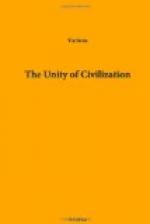What is it now that we find in Defoe and Hogarth? An infinite multitude of detail—we all remember the ‘three Dutch cheeses’ and the ‘fowling-pieces’ which Robinson carefully ferried on his raft from the wreck to the island—an unsparing presentation of all the ugly and sordid realities of life; you might almost say, by preference the ugly realities, the squalid vices, the stupid and brutal ferocity of human nature. It is not a pretty or a pleasing world which we see in Hogarth or in Defoe’s Colonel Jack. But they are great artists. If you see human nature often on its most repulsive side, in its harshest and most repellent form, at least you see in their novels or pictures, the world as they saw it in the streets and taverns, in the police courts and prisons of their day, as for that matter you can still see it everywhere in town or country. The world which they see may often, perhaps usually, be ugly, but at least there is no conventional prettiness, there is no smug veneer of an artificial good taste which refuses to call a spade a spade, and which deliberately turns away from those things in life which are irritating to its sense of decorum and propriety.
Here there is something new, and we can imagine a defender of the nationalist conception of art saying that here at last we have an obvious example of the revolt of northern realism against the southern or classical grace. But there could not be a greater delusion. For though it is true that the new realism was not fully developed all over Europe until the eighteenth century, it had its beginnings in the sixteenth century, and not in the ‘cold’ north, but in the ‘romantic’ south. The first signs of the new movement are to be found not in England or in Flanders, but in Spain in the sixteenth century. It was the Lazarillo de Tormes, the first of the Picaresque novels which struck the new note, which turned from the fantastic and conventional world of the romances in which Don Quixote had nourished his soul, and from the heroic world of beauty and grace of the dramatists, to the bare and hard reality of the life of the beggar and the vagabond. Not even Defoe himself ever surpassed the clearness and precision of the Lazarillo, and it was the first work of a type, whose slow development can be traced in almost every country in Europe: in England, in the realistic attempts of Greene and Nash and Deloney, in Germany in Simplicissimus, in France in the Roman comique of Scarron and in the Gil Blas of Le Sage, who was an almost exact contemporary of Defoe.
And all this can be traced just as clearly in the history of painting. The great Italian painting had ended with the gorgeous magnificence of the Venetian school, with Giorgione and Titian and Tintoretto, and its mastery passed for a few years to Flanders, to Rubens and Vandyck; but in the painting of Spain and of the Low Countries in the later seventeenth century we find ourselves in another world. The little




